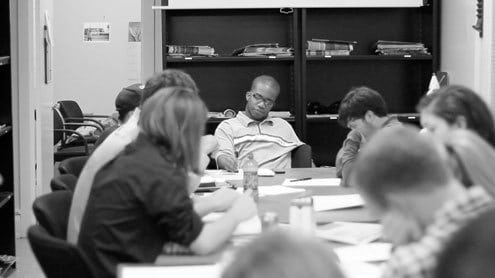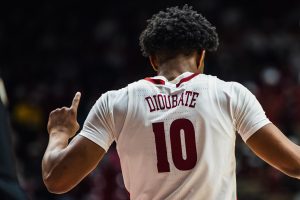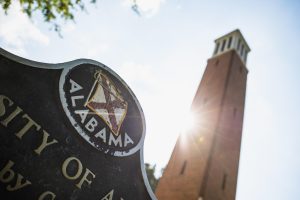How students broke the news of 2011’s tornado super outbreak
Editors at The Crimson White were making the pivot from wire stories to local coverage when a tornado slammed into the community they were just getting to know.

Victor Luckerson, pictured at center, led the paper through covering the 2011 super outbreak. CW file
April 14, 2021
On April 27, 2011, Marion Stallworth’s professor moved her class to the basement of ten Hoor Hall.
The class was taking a final exam when the tornado sirens first started. They were expecting the third tornado warning in two and a half weeks. Stallworth, then the community engagement editor for The Crimson White, finished her final and walked through the empty campus back to her dorm, despite University orders to stay put.
Most of The CW editorial staff was in the old student media building beside Bryant-Denny Stadium, preparing to lay out one of the last papers of the semester. The “Year In Review” edition was on the horizon. While Editor-in-Chief Victor Luckerson and Managing Editor Jon Reed – juniors at the time – held their positions through their senior years, the transition for the other editor positions was underway.
The night before was the first Reed had taken off from work all year for the screening of a documentary class he took that semester. He said he felt immense relief that the class was over and the end of the semester was in sight.
He could see the light at the end of the tunnel. Then suddenly, it was blocked.
On the evening of April 27, Reed was in the student media building with some of the editors watching the news. Five o’clock rolled around and they headed to the basement. Reed said he hunkered under a table to play Words With Friends and wait it out.
Mark Mayfield, the editorial advisor of The CW at the time, looked out of a window facing Bryant-Denny. He saw a funnel cloud. From their perspective, Reed said, it was the size of the stadium.
“That’s the moment we stopped being a student paper,” he said.
Following the story
The first rumor Reed heard was the tornado hit sorority row, so he grabbed a camera and headed that way. Editors became reporters and were sent haphazardly across Tuscaloosa. Reed said he wasn’t sure Luckerson knew where everyone was in the chaos.
It was the first time as a student journalist that Reed went to report without knowing what he would find.
“[News] is out in the city where the tornado actually hit,” he said. “We’re not going to figure it out by sitting around thinking up story ideas. You figure it out by going around and talking to people.”
Stallworth heard rumors that 15th Street had been hit hard and hopped on her bike. She said that the street looked like a warzone, and she couldn’t understand the level of devastation in front of her.
“Even though it had been a couple hours, it still felt like the dust was rising from the ground,” Stallworth said. “There was this haze over everything. All the lights were out or flashing and sirens were everywhere.”
Reed spent most of the following days looking through the viewfinder of a camera. He focused on Holt, Alberta and other neighborhoods that had been hit hard while Assistant News Editor Hannah Mask led the investigations into student deaths.
“None of us had ever covered something like this before,” Reed said. “But afterward, I think we covered everything else better.”
Getting the word out
Editors put out stories as quickly as they could, but logistics were the challenge. There was no service and little internet access the night of April 27, so they went to the design editor’s house for power and published a few stories on the website. The next day, Reed said their coverage found more structure.
They turned to the website to break news. Previously, the website was a place stories went after the paper had been put to bed. Once the newspaper was designed and sent off to print, the stories were published online.
“It was a very early-2000s approach to web content,” Reed said.
Stallworth and the community engagement team spent days at the reins of The CW’s Twitter account, which became a platform for organizing aid locally. Some people interested in shipping supplies to Tuscaloosa reached out to The CW on Twitter, and Stallworth’s team connected them to groups accepting donations. Coordinating those efforts, Stallworth said, was impactful.
In August 2011, The CW had about 500 followers on Twitter. By March, the account had reached 3,300. Stallworth said the account gained another thousand followers every 24 hours after the storm hit — it grew to about 7,000 followers through coverage of the 2011 tornado. Now the account is one of the most followed student newspapers in the country.
The problem with breaking news, Reed said, is that much of the information being shared is not true. Between power outages and overloaded cell towers, social media sites like Twitter became one of the only sources of information. In the confusion, The CW initially misreported the total number of student deaths. Verifying reports of missing students fell on Mask and Stallworth, who developed a system of verification using social media, email, phone calls and on-the-ground reporting.
In the days following, many members of The CW’s editorial staff stayed in Tuscaloosa despite the University’s shutdown on April 28. The CW published its first paper since the storm on May 4. Stallworth handed out a stack of papers at a local grocery store.
She held copies of the paper out of her car window. Residents immediately grabbed the papers, the first offline source of concrete information since April 27.
“I felt the power of journalism in us getting that in people’s hands, and also the emotion to have everything that was in that paper and everything that we had just experienced,” she said.
The experience of reporting on disaster left an impact on all reporters involved. Vickerson said that, had he been able to do anything differently, he would have found a mental health professional to support his staff both during and after the disaster.
“Student journalists were writing obituaries, interviewing people who had lost everything, and surveying scenes of destruction where people were actively searching for the missing or the deceased… ” Luckerson said. “Looking back I wish we had brought a therapist or mental health expert into the newsroom during that period, and had a chance to work through what we were all witnessing, both in individual sessions and as a group.”




















